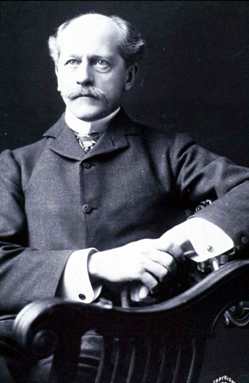
As geologist and science writer Nina Morgan discovers, geology of a sort has already provided clues to life on Mars
In his search for life on Mars, the 19th Century astronomer Percival Lowell is often considered to be a figure of fun today. But perhaps we only scorn his ideas now because they were actually ahead of their time. The Mars Rover Curiosity (see Online Special) carries instruments like the Mars Hand Lens Imager, as well as a range of spectrometers to study the mineralogy of rocks on the surface and high resolution cameras to photograph landforms. His conclusions may be different, but like NASA scientists today, Lowell relied on geological evidence as he searched for life on Mars.
Lowell believed that a network of canals which he mapped on the surface of Mars represented irrigation canals, demonstrating that water and intelligent beings once existed there. In his book Mars (1895), Lowell compared the general geological characteristics of Mars with those of Earth.
“Now, in the special case of Mars, we have before us the spectacle of a world relatively well on in years, a world much older than the Earth … Advancing planetary years have left their mark legible there. His continents are all smoothed down; his oceans have all dried up. Teres atque rotundus, he is a steady-going body now… But from the fact that our own development has been comparatively a recent thing, and that a long time would be needed to bring even Mars to his present geological condition, we may judge any life he may support to be not only relatively, but really older than our own. From the little we can see, such appears to be the case.”
So far, so reasonable. But then he goes on to note that:
“The evidence of handicraft [i.e. the building of the canals], if such it be, points to a highly intelligent mind behind it. Irrigation, unscientifically conducted would not give us such truly wonderful mathematical fitness in the several parts to the whole as we there behold. A mind of no mean order would seem to have presided over the system we see – a mind certainly of considerably more comprehensiveness than that which presides over the various departments of our own public works. Party politics, at all events, have had no part in them; for the system is planet wide. Quite possibly, such Martian folk are possessed of inventions of which we have not dreamed … Certainly what we see hints at the existence of beings who are in advance of, not behind us, in the journey of life. “
Although his comments on public works and party politics may still ring true, his ideas about intelligent beings are perhaps a little strange. A case of ‘logic – but not as we know it’!
Acknowledgement
This vignette was inspired by news about the Curiosity landing reported in articles including: There’s life on Mars, by geologist and journalist Michael Hanlon, on www.telegraph.co.uk on 6 August 2012; the blog feature, Life on Mars? Curiosity drops in to find out by Stephen Harris, at www.theengineer.co.uk (3 August 2012) as well as pictures and captions at mars.jpl.nasa.gov/msl/multimedia/images/ . Other sources include Mars by Percival Lowell, Houghton, Mifflin and Company. An html version of Mars is available at www.wanderer.org/references/lowell/Mars/.
If the past is the key to your present interests, why not join the History of Geology Group (HOGG)? For more information and to read the latest HOGG newsletter, visit: www.geolsoc.org.uk/hogg, where the programme and abstracts from the Conference on Geological Collectors and Collecting are available as a pdf file free to download.
*Nina Morgan is a geologist and science writer based near Oxford.